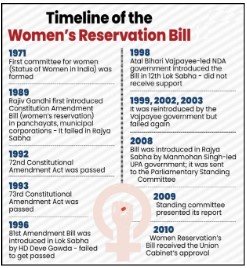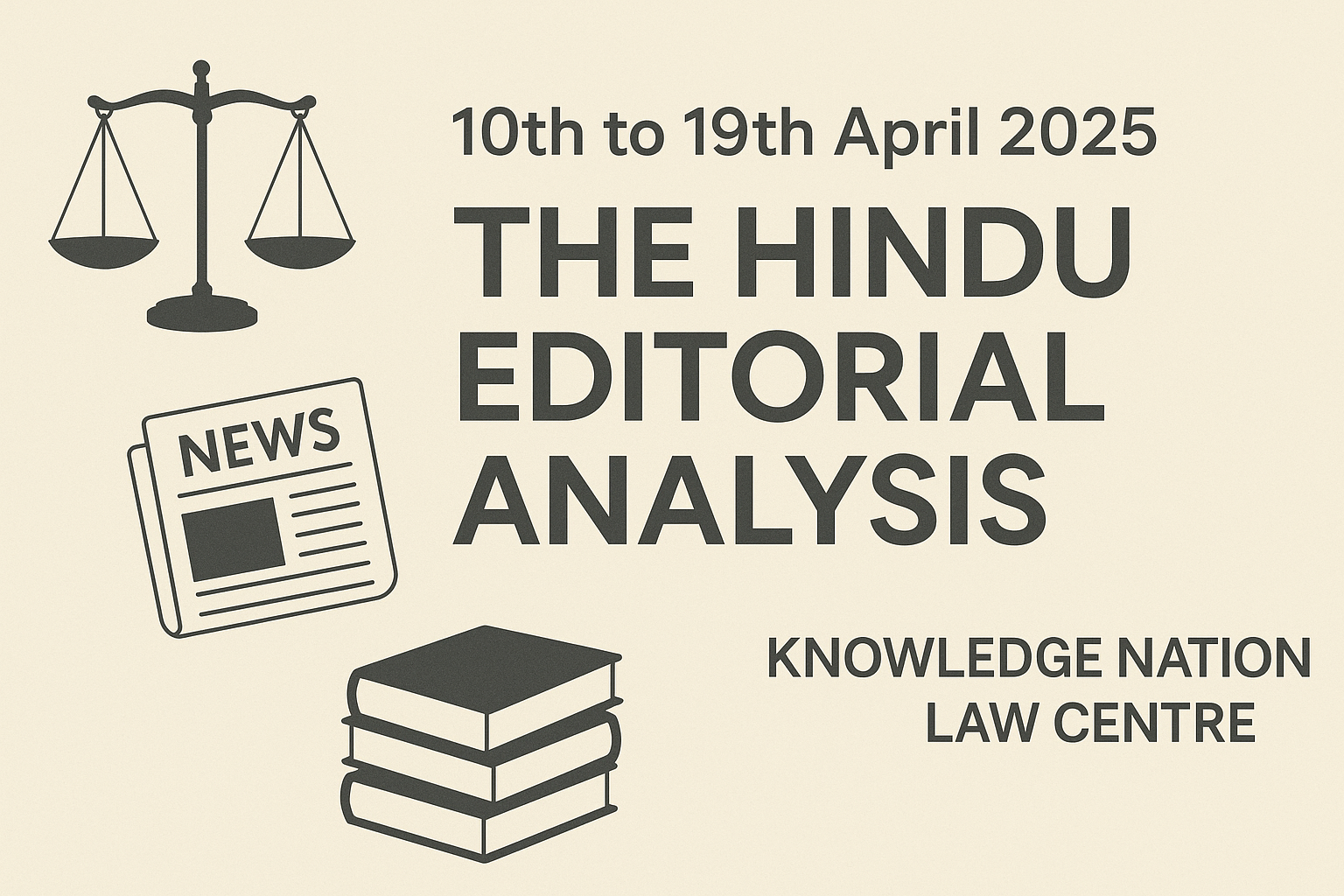10th to 19th April 2025 : The Hindu Editorial Analysis
1.Understanding India’s China conundrum
(Source – The Hindu, International Edition – Page No. – 8)
Topic: International Relations
Context
- The article highlights China’s growing military capabilities and its increasing influence in India’s neighbourhood, raising concerns for India’s national security and foreign policy.
Change in China’s Approach Under New Leadership
- China today is very different from what it was a few decades ago.
- Since 2013, it has shown increasing aggression, especially near its borders.
- It often refers to its past and claims it has been wronged, trying to restore old frontiers like those of the Qing Dynasty.
- This attitude has become a cause of concern for neighbouring countries like India.
Pattern of Border Skirmishes
- There have been several clashes between Indian and Chinese troops over the years: in 2013 (Depsang), 2016 (Demchok), 2017 (Doklam), and 2020 (Galwan).
- Despite occasional friendly diplomatic gestures, these incidents show a pattern of growing tension.
- Any recent positive signals must be viewed with caution, and one should not assume relations are returning to the earlier, more peaceful period.
Signs of De-escalation in 2024
- Towards the end of 2024, tensions slightly reduced and patrolling at disputed border points was adjusted.
- These developments were discussed just before a major international summit.
- A new agreement on patrolling was introduced, but many details remain unclear.
- Although the situation improved, both sides still remain cautious, especially along the Line of Actual Control (LAC).
To Enroll in Knowledge Nation Law Centre - Click Here
Military Preparations and Strategic Concerns
- In early 2025, one country claimed that normalcy had returned after high-level talks.
- Talks between the two sides may resume soon, but true progress will require detailed and transparent agreements.
- In March, China increased its defence budget by 7.2%, almost three times more than India’s, which spends less than 2% of its GDP on defence.
- Over one lakh troops, with heavy weapons, remain deployed in the Himalayan region.
- Reports suggest China is also increasing its nuclear warheads, with a possible addition of around 100 warheads recently.
Technological and Military Superiority
- China has a significant lead in Artificial Intelligence (AI), cyber warfare, and military technology.
- It is ahead in anti-satellite capabilities, quantum tech, and digital battlefield tools.
- These developments show that peaceful talks alone are not enough; India must stay alert and prepared.
Diplomatic Moves in India’s Neighbourhood
- China is increasing its presence in countries close to India, like Bangladesh.
- As India strengthens ties with global powers, it must not neglect its neighbours.
- China is also expanding in Africa, especially in the nuclear energy sector, which can affect India’s energy security.
Conclusion
- India must stay prepared for all outcomes, including sudden changes in global partnerships.
- Both countries have ancient histories and can manage their differences, but strategic caution is necessary in the present environment.
Join WhatsApp community for Free Notifications, Updates, Study Material, Mock Tests, Internship Updates, and Current Affairs - CLICK HERE TO JOIN
2. The Rohingya are on the brink of starvation
(Source – The Hindu, International Edition – Page No. – 9)
Topic: International Relations
Context
- Over one million Rohingya refugees in Cox’s Bazar face a deepening humanitarian crisis.
- The situation worsened after a major donor suddenly withdrew vital aid support.
Rohingya Crisis in Cox’s Bazar
- Cox’s Bazar hosts over one million Rohingya refugees, making it one of the largest and most neglected humanitarian crises in the world.
- These refugees are now facing even worse conditions due to the sudden withdrawal of funding by the U.S. Agency for International Development (USAID).
Withdrawal of USAID Funding
- USAID, previously the world’s largest donor to humanitarian causes, spent around $40 billion annually across the globe.
- This funding has been cut by the Department of Government Efficiency, which was created under the U.S. administration.
- Bangladesh was the second-largest recipient of USAID in South Asia, and the sudden withdrawal has severely affected the Rohingya refugees.
Impact on Refugees
- The decision to reduce USAID support has had serious consequences for humanitarian work globally.
- For the Rohingya refugees, who already suffered genocide and displacement, this has made their lives worse.
- The World Food Programme (WFP) had to reduce monthly food rations from $12.50 to $6 per person.
- Medical support has declined sharply, with five hospitals shutting down and sanitation projects collapsing.
To Enroll in Knowledge Nation Law Centre - Click Here
Ideological Shift and Moral Concerns
- The funding cuts reflect an ideological shift that favours private, profit-based aid instead of structured, government-led support.
- Hunger, displacement, and genocide are moral problems, not just financial issues.
- Believing that charity or private funding can replace long-term government aid is unrealistic and dangerous.
Global and Regional Impact
- The collapse of USAID’s support has especially affected services for women and children, increasing their risk of exploitation.
- The move also affects U.S. soft power in South Asia.
- China is stepping in to fill the gap, increasing its influence in Bangladesh and mediating repatriation talks between Bangladesh and Myanmar.
A Call for Action
- Other countries like the European Union (€32.3 million), Japan, and Italy have pledged aid, but they cannot replace USAID’s scale.
- The situation serves as a test for the world’s commitment to humanity.
Join WhatsApp community for Free Notifications, Updates, Study Material, Mock Tests, Internship Updates, and Current Affairs - CLICK HERE TO JOIN
3. Drop the piecemeal ways to social security for workers
(Source – The Hindu, International Edition – Page No. – 8)
Topic: Social Security
Context
- India is working to extend social security benefits to gig workers through a central scheme.
- This effort highlights the need for a universal, inclusive social protection framework for all informal workers.
New Steps Towards Social Security for Gig Workers
- India is moving forward with a central scheme for online (app-based) gig workers, which is awaiting Cabinet approval.
- The scheme offers health coverage under Ayushman Bharat, and registration on the eShram portal to help workers access different social security benefits.
- A transaction-based pension system is planned, using a universal account number to track earnings across platforms and ensure companies contribute to pensions.
- This pension plan recognizes that gig workers may have multiple employers and ensures shared responsibility for worker welfare.
- Since social security in India is usually linked to formal employment, this step is significant in bringing informal gig workers into the fold.
Limitations in the Existing Social Protection System
- Although India helped form the International Labour Organisation, it has not ratified the Social Security (Minimum Standards) Convention, 1952 (No. 102).
- India passed the Code on Social Security nearly 70 years later, aiming to create a broader protection framework.
- However, this Code has been criticized for vague definitions, weaker protections, and challenges in implementation.
- The Code relies on welfare boards to provide benefits, but these boards often fail to meet goals.
- A Right To Information finding revealed that states had not used ₹70,744.16 crore collected as welfare cess from employers.
- A 2024 audit report showed delays in remittance of ₹221.8 crore by 99 local bodies in Tamil Nadu to the Construction Workers Welfare Board.
- Even in states with strong welfare records, like Kerala, only 5 out of 16 boards functioned effectively, and some reported no beneficiaries.
To Enroll in Knowledge Nation Law Centre - Click Here
Problems With a Fragmented Approach
- Some argue that welfare boards offer targeted relief, like Karnataka’s beedi and cigarette workers requesting revival of a defunct fund.
- However, focusing on one group at a time ignores the uncertain nature of informal work in general.
- It can also create unfair divisions between types of informal work, such as between gig workers and domestic workers.
- Relying on gig work alone to formalize informal labour is overly optimistic, as new job types will continue to emerge.
Building a Universal Social Protection Framework
- India needs a future-ready social protection system that adjusts with changes in work types and sectors.
- The Code is likely to stay, even with its issues. States can still develop their own measures within its structure.
- A good starting point would be to treat the Code as a minimum standard and build upon it to create a stronger, more inclusive, and universal system.
- The ultimate goal should be a framework that includes every worker, without exception, and can adapt over time.
Join WhatsApp community for Free Notifications, Updates, Study Material, Mock Tests, Internship Updates, and Current Affairs - CLICK HERE TO JOIN
4. Are existing mechanisms effective in combating judicial corruption?
(Source – The Hindu, International Edition – Page No. – 9)
Topic: Indian Polity – Judiciary
Context
- Recently, a large amount of unaccounted cash was reportedly found at the residence of a former High Court judge.
- This has sparked a broader debate on the effectiveness of existing mechanisms to combat corruption in the judiciary.
Effectiveness of Impeachment
- The process of impeachment is extremely difficult and rarely successful, requiring a two-thirds majority in both Houses of Parliament.
- While it protects judicial independence by preventing misuse for political gains, it is not effective as a deterrent against corruption.
- A transparent internal system within the judiciary is needed to handle cases of serious misconduct and maintain public trust.
Need for Reforms in In-House Procedures
- The current internal mechanism was created to prevent misuse of legal action by the executive against judges.
- It gained recognition after a major court ruling in 1991, which issued safeguards for judicial officers.
- However, the mechanism may benefit from legal reforms to ensure greater accountability and efficiency.
- Past cases show that judicial corruption is difficult to prosecute due to weak enforcement and protection offered to judges.
To Enroll in Knowledge Nation Law Centre - Click Here
Importance of Making Inquiry Reports Public
- Greater transparency in inquiry procedures is essential in today’s environment of constant public scrutiny.
- Making reports public can help reinforce trust in the judiciary and avoid speculation.
- However, transparency should be balanced with protecting the rights of the accused and maintaining the fairness of the inquiry.
- Communication must be clear to prevent misinformation and protect the reputation of the institution.
Revisiting the Role of the Executive in Appointments
- The executive already plays an informal yet significant role in judicial appointments through background checks and delayed approvals.
- The current system allows the executive to block appointments without formal rejection.
- Transparency and clarity in the selection process are more important than which body—government or judiciary—makes the appointments.
Why Past Bills May Not Help
- A previous bill aimed at judicial accountability failed to address important gaps.
- Instead of more oversight bodies, clear standards of conduct and internal mechanisms like peer reviews should be developed.
- Disclosure of family members in the legal profession and structural changes are necessary to avoid conflicts of interest.
Need to Liberalise Contempt Laws
- The fear of contempt should not stop people from discussing judicial corruption in good faith.
- There should be space for constructive criticism without the threat of criminal penalties.
- Reforms must ensure judges do not misuse contempt laws to avoid scrutiny.
- Institutional changes are necessary to allow for open and fair public discussion about judicial integrity.
Join WhatsApp community for Free Notifications, Updates, Study Material, Mock Tests, Internship Updates, and Current Affairs - CLICK HERE TO JOIN
5. The Beijing India Report as a milestone and opportunity
(Source – The Hindu, International Edition – Page No. – 6)
Topic: Social Justice
Context
- Climate change and migration are forcing many girls in rural India to drop out of school.
- This is especially concerning in areas like Chhattisgarh, where expectations were high for a better future for girls.
Beijing Declaration and Its Gaps
- 30 years after the Beijing Declaration on gender equality, India has made progress in laws like the Domestic Violence Act and POSH Act.
- However, poor implementation continues to create a gap between women’s rights and their real experiences.
Need to Connect Gender and Climate Issues
- Gender inequality and climate change are closely linked, especially in rural communities.
- India’s Beijing+30 Report lacks a strong climate perspective, missing a crucial opportunity to integrate gender and climate concerns.
Climate Impacts on Rural Women
- Women in rural areas face inequality, lack of resources, and decision-making power.
- They are highly affected by climate events like droughts and heatwaves, leading to malnutrition, infertility, and menstrual health issues.
- These issues contribute to income loss and distress migration.
- Nearly 33% of income is lost, especially from non-farm work.
Low Focus on Gender in Climate Policies
- Only 6% of climate policies mention women, 1% mention the poor, and 6% mention farmers.
- Climate change increases women’s unpaid care work like water collection and fuel gathering.
- Women in India work over 8 hours daily, with 71% of their work being unpaid.
- Without action, unpaid work could rise to 8.3 hours daily by 2050.
To Enroll in Knowledge Nation Law Centre - Click Here
Health and Violence Issues
- Over 50% of pregnant women in India are anaemic, worsened by food insecurity.
- Women with food insecurity are 1.6 times more likely to suffer from anaemia.
Women’s Role in Climate Adaptation
- Women, especially in rural areas, hold key traditional knowledge for sustainable farming.
- They preserve climate-resilient seeds and respond first during disasters.
- Indigenous women prioritize forest livelihoods, safety due to resource conflict, and managing migration issues.
Need for Climate-Gender Integration in Plans
- The national and state climate action plans need to include gender-specific focus.
- Climate budgeting must be gender-audited to avoid greenwashing.
- Rural women should have platforms to make climate-related decisions and access support services.
Promoting Women’s Leadership and Research
- Community climate meetings must involve women and encourage them to lead green projects.
- Better data, indicators, and research on the gender-climate connection are needed.
- Closing gender gaps in agriculture could boost food production by 20%-30% and feed 100-150 million more people.
Policy and Livelihood Support
- Disaster preparedness, protection against trafficking, elderly care, and non-farm job training for women are essential.
- Gender-responsive climate policies must be implemented at the ground level.
Role of Private Sector and Partnerships
- Green funds should support women-led innovations and climate-friendly businesses.
- The private sector must promote gender-inclusive climate solutions and resilience-building technologies.
- Cooperation among government, civil society, businesses, and international groups is vital for empowering women and ensuring a sustainable future.
Join WhatsApp community for Free Notifications, Updates, Study Material, Mock Tests, Internship Updates, and Current Affairs - CLICK HERE TO JOIN
6. Giving shape to the university of the future
(Source – The Hindu, International Edition – Page No. – 6)
Topic: Social Justice – Education
Context
- India’s National Education Policy envisions transforming higher education through multidisciplinary, cross-disciplinary, and interdisciplinary approaches.
- This requires structural, financial, and regulatory reforms across institutions.
NEP’s Vision for Higher Education
- The National Education Policy aims to end the siloed system of higher education in India.
- It promotes large multidisciplinary institutions that support cross-disciplinary and interdisciplinary education.
- The focus is on encouraging communication, debate, research, and integrated thinking across subjects.
Understanding the Terms
- Multidisciplinarity means different disciplines working in the same space without interaction. Each maintains its own methods.
- Cross-disciplinarity involves collaboration and dialogue between disciplines but without merging methods or knowledge.
- Interdisciplinarity goes further by integrating methods and knowledge from different disciplines to solve complex problems.
To Enroll in Knowledge Nation Law Centre - Click Here
Developing Multidisciplinary Campuses
- The NEP proposes phasing out single-stream institutions to create multidisciplinary campuses.
- This can be done in two ways:
- Adding new departments to broaden focus (e.g., engineering institutions adding humanities).
- Creating university clusters by connecting nearby institutions (e.g., arts and commerce colleges collaborating).
- According to AISHE 2020-21, 35% of undergraduate colleges are single-stream, many offering only B.Ed., making clustering difficult.
- New multidisciplinary universities will need to be built, ideally one in every district by 2030, instead of scattered campuses, to improve efficiency.
- Public universities are more efficient in education but less so in research, especially with multiple campuses.
Promoting Cross-disciplinary Practice
- Future universities must not only host different departments but also promote collaboration and openness.
- Students and faculty should be exposed to diverse subjects beyond their core areas.
- Cross-disciplinary learning starts with students taking courses from other departments.
- The next step is joint research projects involving faculty and students from different disciplines.
- Sustaining such efforts needs long-term funding and incentives.
Encouraging Interdisciplinary Thinking
- Cross-disciplinary efforts lay the foundation, but interdisciplinary thinking requires integrating knowledge deeply across fields.
- Some combinations (like biotechnology and medicine) succeed, but others (like engineering and architecture) face publication and career challenges due to lack of fit in existing academic structures.
- To support interdisciplinarity, there is a need to reform funding, faculty recruitment, promotions, and academic publishing practices.
Conclusion
- These transformations will require major investments over many years.
- Public spending must be reprioritised, and regulatory changes should be carefully designed.
- The goal is to build a higher education system similar to successful international models that evolved over decades.
Join WhatsApp community for Free Notifications, Updates, Study Material, Mock Tests, Internship Updates, and Current Affairs - CLICK HERE TO JOIN
7. A Governor’s conduct and a judgment of significance
(Source – The Hindu, International Edition – Page No. – 8)
Topic: Polity and Constitution
Context
- A recent Supreme Court judgment clarified that a Governor is not an independent authority but must follow legal rules and democratic principles.
- The Court emphasized that the Governor is not a representative of the Union government nor a separate power center.
Governor’s Role in Respecting Democracy
- The main issue was about the Governor not acting on Bills passed by the State Legislative Assembly.
- The Court confirmed that delaying or refusing to act on Bills without reason goes against the Constitution and democracy.
- The case involved 12 Bills, some from as early as 2020, including laws that would limit the Governor’s role in appointing Vice-Chancellors.
Delay in Action and Legal Challenge
- The Governor took no action on the Bills for a long time.
- When the State government approached the Supreme Court in 2023, the Governor referred two Bills to the President.
- The Assembly then re-passed 10 Bills in a special session, but the Governor again sent all of them to the President.
- Out of these, the President approved only one Bill, rejected seven, and left two undecided.
Federal Structure and Division of Powers
- India’s Constitution separates powers between the Union and State governments.
- States have full authority over subjects listed in List II of the Constitution’s Seventh Schedule.
- Even though the Governor is appointed by the Union, he is supposed to act on the advice of the State’s Council of Ministers, except in limited cases.
To Enroll in Knowledge Nation Law Centre - Click Here
Understanding Article 200
- Article 200 explains what a Governor can do when a Bill is passed by the Assembly.
- The Governor can either approve it, return it for reconsideration, or reserve it for the President.
- The Union argued that the Governor could withhold assent without explanation — a kind of pocket veto.
- But the Court rejected this, based on a previous case, stating that there is no such independent power.
Discretionary Powers and Judicial Review
- The Court listed only three rare situations where the Governor can act without advice:
- If a Bill affects the powers of a High Court.
- If the Constitution requires the President’s approval (e.g., under Article 31C).
- If a Bill goes against core constitutional values.
- Even then, the Governor’s actions can be reviewed by courts, since Article 361 protects the Governor personally but not his decisions.
Court’s Final Decision Using Article 142
- The Court found the Governor’s actions unconstitutional.
- It could have ordered the Governor to approve the Bills, but that would be hard to enforce.
- Instead, using its power under Article 142, the Court declared that the 10 Bills were deemed to be approved from the date they were re-submitted.
Conclusion
- This decision not only resolved the issue with the Bills but sent a strong message.
- It confirmed that the Governor must work with the State government and uphold democracy.
- The office of the Governor is meant to protect the Constitution, not create political conflicts.
Join WhatsApp community for Free Notifications, Updates, Study Material, Mock Tests, Internship Updates, and Current Affairs - CLICK HERE TO JOIN
8. History as battlefield — the perils of reversing the past
(Source – The Hindu, International Edition – Page No. – 8)
Topic: History
Context
- In March 2025, many textbooks were revised to remove or criticize some historical figures while glorifying certain native rulers.
Textbook Changes and Public Sentiment
- This change came alongside growing public anger demanding renaming or destruction of Mughal-era tombs.
- Viral campaigns called for vandalism of historical monuments, based on a black-and-white view of India’s past.
- Supporters claimed these moves corrected biased portrayals, but such selective rewriting increased societal divisions.
Why History Needs Nuance?
- History should be studied with careful thought, considering causes, consequences, and context.
- When it is used as a political weapon to bring back a perceived lost glory, it becomes divisive.
- Trying to undo the past instead of understanding it leads to more conflict and hinders progress.
- Remembering historical wrongs is important, but they should not be used to reclaim past status or borders.
Revisionism vs. Reinterpretation
- It is important to separate political revisionism from genuine academic reinterpretation.
- Reinterpretation is based on new evidence or perspectives and helps deepen our understanding.
- Political revisionism twists history to support current agendas, often linked to identity and nationalism.
- Historical examples like the religious wars in Europe and the wars over sacred sites show how attempts to reverse history caused deep divisions and violence.
Consequences in History of Weaponised Past
- The wars in Europe during the 16th and 17th centuries showed how religious and political groups tried to restore their dominance based on past grievances.
- These wars caused millions of deaths, destroyed economies, and led to prolonged suffering.
- The attempt to justify present actions by referring to historical events led to more hatred and conflict.
To Enroll in Knowledge Nation Law Centre - Click Here
Modern-Day Examples of Revisionism
- The 20th century saw destructive revisionism, where manipulated history was used to justify violence and conquest.
- In one case, a major European power tried to regain lost glory and overturn peace treaties, resulting in a global war and genocide.
- The Partition of India in 1947 was another example, where selective historical memories fueled communal violence and mass displacement.
- Today, regions like the Middle East and Eastern Europe continue to suffer due to attempts to reverse history and reclaim disputed lands.
History Must Be a Teacher, Not a Weapon
- History should guide us to avoid past mistakes, not be used as a model to recreate them.
- Nations must look forward instead of trying to recreate a glorified past.
- Selectively remembering the past to justify revenge leads to more violence.
- True learning from history requires humility, mutual respect, and a forward-looking approach.
Join WhatsApp community for Free Notifications, Updates, Study Material, Mock Tests, Internship Updates, and Current Affairs - CLICK HERE TO JOIN
9. Feminism for polarised times
(Source – The Hindu, International Edition – Page No. – 9)
Topic: Social Justice
Context
- The discourse on the Women’s Reservation Bill, 2023 has reignited debates around gender equity, highlighting the need for a more inclusive and nuanced feminism.
Women’s Reservation and Mainstreaming Gender Equity
- The Women’s Reservation Bill, 2023 brought gender equity into the core of political discussions.
- No institution can now ignore the demand for women’s representation.
- However, this mainstreaming has made it harder to engage critically, as the discourse can feel rigid or exclusionary.
Structural vs. Interpersonal Terrain
- Discussions around women’s issues operate on two levels: structural inequalities and interpersonal relationships.
- The structural level involves social systems that keep women at the margins.
- The personal level includes everyday relationships, often shaped by care and mutual dependence.
- Using only the structural lens can misinterpret personal relationships as purely oppressive, ignoring love, negotiation, and complexity.
Human Complexity in Gender Roles
- Many men silently sacrifice personal comfort to support families.
- Relationships often show a mix of traditional expectations and mutual support.
- These realities are not straightforward expressions of patriarchy but reflect a complex balance of emotions, duties, and shared responsibilities.
Social Change at Multiple Levels
- While problematic behaviours must be challenged, not all require the label of misogyny.
- Change comes through public policy and daily life negotiations — such as altered family roles or unexpected support from relatives.
- Marginalised women’s success stories often involve male allies, showing that progress includes nuanced cooperation.
Addressing Structural Violence
- In cases where women are forcibly denied agency — such as honour killings or proxy politics — structural reforms and strong legal enforcement are essential.
- True empowerment involves multiple factors: economic independence, legal safeguards, education, and social support systems.
To Enroll in Knowledge Nation Law Centre - Click Here
Misrepresentation of Inequities
- A financially independent urban woman’s challenges differ greatly from a rural woman’s vulnerability to violence.
- Feminist discourse often merges different struggles into one narrative, which can mask real inequities and alienate those it seeks to engage.
Need for Compassionate Feminism
- A more empathetic feminist approach may reduce backlash and encourage solidarity.
- Recognising men’s hardships, especially those at the margins, can build mutual understanding.
- A balanced feminism must handle contradictions, distinguish between structures and sentiments, and promote change without conflict as the first step.
Join WhatsApp community for Free Notifications, Updates, Study Material, Mock Tests, Internship Updates, and Current Affairs - CLICK HERE TO JOIN
10. India, rising power demand and the ‘hydrogen factor’
(Source – The Hindu, International Edition – Page No. – 8)
Topic: Indian Economy – Infrastructure – Energy
Context
- India’s path to a net-zero economy requires massive electrification and increased use of low-carbon energy sources, including nuclear and hydrogen.
- Strategic integration of electricity storage and hydrogen production is essential for sustainable energy transition.
Need for Electrification and Hydrogen in a Net-Zero Economy
- To achieve a net-zero economy, massive electrification of all energy uses is necessary.
- Fossil fuels are not only used for generating electricity but also for providing heat and essential molecules in industries.
- For example, carbon from coal is used in steel production, and hydrogen from natural gas is used to produce ammonia for fertilizers.
- In the steel industry, hydrogen can replace carbon, supporting the move towards net-zero emissions.
- Therefore, electrification of energy use and hydrogen adoption in industries are key steps toward decarbonization.
Growing Power Demand and Nuclear Expansion Plans
- As India moves towards becoming a developed nation with net-zero emissions, electricity demand is expected to rise sharply.
- Solar, wind, and hydro energy sources alone cannot meet this demand. Nuclear energy is necessary as part of the energy mix.
- India aims to achieve 100 GW of nuclear power installed capacity by 2047.
- Currently, several 700 MW Pressurized Heavy Water Reactors (PHWRs) are operational or under construction across the country.
- A total of 26 PHWR units of 700 MW are planned, showcasing a significant nuclear power expansion.
- Bharat Small Reactors (BSRs) of 220 MW are also being proposed for captive use by public sector enterprises.
Role of Low-Carbon Energy Sources
- In the future, electricity from low-carbon sources like hydro, nuclear, solar, and wind will increase.
- Solar and wind are intermittent, while nuclear is ideal as a base-load power source.
- Presently, coal-fired plants are adjusted (flexed) to match demand during solar energy availability.
- This helps reduce emissions but flexing is not suitable for nuclear plants due to high capital cost and technical challenges.
To Enroll in Knowledge Nation Law Centre - Click Here
Hydrogen Production as a Better Alternative to Flexing
- Flexing nuclear plants is expensive and technically difficult.
- Instead, surplus electricity from solar, wind, or nuclear sources can be used to produce hydrogen using electrolysers.
- This approach avoids the need to flex power plants and also reduces the need for large-scale battery storage.
- Electrolysers are low-cost and flexible in operation. Hydrogen thus produced is used in industries, not reconverted to electricity.
Incentives and New Classification for Hydrogen
- The government currently incentivizes “green hydrogen” made using solar and wind electricity.
- A certification scheme defines green hydrogen as having emissions below 2 kg CO₂/kg H₂.
- Since nuclear and renewable hydrogen have similar life-cycle emissions, it is proposed to change the classification to “low-carbon hydrogen” to include nuclear-based hydrogen.
Need for Integration of Hydrogen and Electricity Storage
- Currently, hydrogen production and electricity storage are treated separately.
- These two need to be combined to improve cost efficiency.
- Case studies show that integrating battery storage and hydrogen production can improve overall economics.
Policy Recommendations
- Redefine “green hydrogen” as “low-carbon hydrogen” based on emission thresholds.
- Encourage synergy between electricity storage systems and hydrogen production to enhance energy efficiency and reduce costs.
Join WhatsApp community for Free Notifications, Updates, Study Material, Mock Tests, Internship Updates, and Current Affairs - CLICK HERE TO JOIN
11. Shaping a response to the U.S.’s reciprocal tariffs
(Source – The Hindu, International Edition – Page No. – 8)
Topic: International Relations
Context
- The U.S. has introduced new reciprocal tariffs based on trade imbalances, impacting global trade flows and countries like India.
- This move raises concerns over protectionism and challenges multilateral trade norms.
Introduction of New U.S. Tariffs
- The U.S. has introduced new reciprocal tariffs that apply both country-wise and commodity-wise.
- These tariffs include an existing import duty and an additional country-specific tariff for all goods.
- The additional reciprocal tariffs are currently on hold and limited to 10% for 90 days, except for one major country.
Goods Exempted from Additional Tariffs
- Some key goods are exempt from the additional tariff: Steel and aluminum articles, autos and auto parts, copper, pharmaceuticals, semiconductors, lumber, bullion, energy products, and certain critical minerals not available in the U.S.
Impact on Indian Exports
- India’s overall exports to the U.S. are modest and have declined in recent years.
- The additional 26% tariff will have varied effects on different export items.
- Key Indian exports to the U.S. include electrical machinery, gems and jewellery, machinery, mineral fuels, and iron and steel products.
- Pharmaceuticals are currently exempt, and gems and jewellery may not be severely affected due to inelastic demand.
- The most affected items would be electrical machinery, mechanical appliances, and made-up textiles.
- Competing countries like Vietnam, Cambodia, Bangladesh, and China also face high reciprocal tariffs, making India relatively competitive.
To Enroll in Knowledge Nation Law Centre - Click Here
India’s Strategic Response
- India imports many essential goods from the U.S., making any retaliatory tariff harmful domestically.
- A smart response could be to increase imports from the U.S. in areas like petroleum, which would reduce India’s reciprocal tariff rate to 11.8%, close to the minimum of 10%.
- This strategy would shift India’s import composition without increasing the current account deficit.
Global Trade Concerns and the Role of WTO
- Aggressive tariff actions by major countries have led to steep tariff hikes in some cases, such as 145% to 245%.
- Such steps cause global trade uncertainty and harm growth prospects.
- There is a need for a fair and transparent world trade system with low tariffs.
- The World Trade Organization should lead efforts to create a stable global trading environment.
- Until then, regional trade agreements should be pursued as temporary alternatives.
Practice Question: Discuss the implications of the U.S. reciprocal tariff policy on India’s trade competitiveness. How should India calibrate its response in a multilateral trade framework? (150 Words /10 marks)

 Info@Knowledgenation.co.in
Info@Knowledgenation.co.in











Leave a Comment